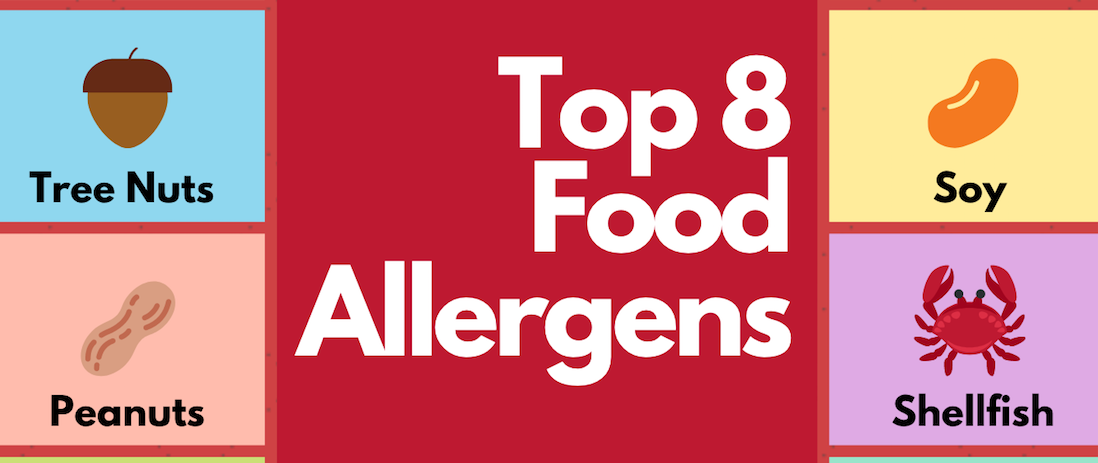If you’ve seen any of our social media or blog posts you’ve likely heard us tout our products as being free from contamination by the top 8 allergens. If you’re someone who suffers from food allergies and are wondering which foods you should avoid and which foods are safe to eat, keep reading!

Here is a list of the top 8 allergens:
1. Milk
Milk accounts for the most commonly occurring food allergy in infants and toddlers, but thankfully, up to 90% of kids outgrow their milk allergy by the age of 6. Few adults are affected by this allergy. With milk being so prevalent in many cuisines, those with milk allergies must always be cautious as milk can often be hidden in many prepared foods including baked goods and protein powders. Don’t fret though, since a plethora of delicious milk substitutes exist, with our 2 favorites being almond milk and oat milk.
2. Eggs
Similar to milk, egg allergies seem to be incredibly common in infants before they are outgrown by early childhood. Virtually all of the proteins that have been tied to egg allergies are found in the egg white but, of course, those with egg allergies should avoid the entire egg. Eggs also tend to hide in many different foods: baked goods, pastas, mayonnaise and salad dressings. Those with an egg allergy can substitute vegan egg powder for eggs when baking or cooking breakfast.
3. Fish
Even though there are many different types of fish, individuals who are allergic to one type of fish tend to be allergic to many species of finned fish. Unlike milk and eggs, over 40% of fish allergies don’t develop until adulthood. It may seem easy to avoid eating fish, but fish is used in many prepared foods, including Caesar dressings and Worcestershire sauce. Luckily, those with a fish allergy can get their proteins and healthy fats from other foods like lean meats, nuts, and avocados.
4. Shellfish
An allergy to one type of finned fish typically equates to an allergy to all finned fish, but it does not always equate to a shellfish allergy. Shellfish encompass all fish with a shell, like shrimp, crab, and lobster, and it’s most common for older children and adults to suffer from this type of food allergy. People with shellfish allergies should read foods labels very carefully as shellfish can also be found in many sauces and dressings, particularly in Asian prepared foods.
5. Tree Nuts
There are many different types of tree nuts, but the most well-known are almonds, cashews, pecans and walnuts. Nuts are the most potent of the top 8 allergens; consuming a very small amount—and even just touching or inhaling them—can cause anaphylactic shock, so those with nut allergies should be extremely cautious of cross- contamination when eating out.
6. Peanuts
With how often we tend to hear about peanut allergies nowadays, it’s quite shocking to learn that less than 1% of the US population suffers from this allergy. Peanuts are a type of legume, a crop that accounts for over 25% of crop production in the nation, and thus are very commonly used in packaged foods. People eat them on their own, add them to chocolate bars and trail mixes, use them in savory recipes, and of course, consume them in peanut butter and jelly sandwiches. Those with peanut allergies don’t have to miss out on this classic staple; substituting sunflower butter for peanut butter is incredibly delicious and satisfying – try it the next time you crave a childhood snack!
7. Wheat
Wheat is one of the world’s most commonly consumed grains. Wheat allergies are often mistaken for Celiac disease, but they are actually quite different. Celiac Disease is characterized by a distinct reaction to gluten, a type of protein found in wheat, while general wheat allergies can be caused by a reaction to over 27 different allergens, separate from gluten. Foods that are safe for those with a wheat allergy may not be safe for those with a gluten allergy and vice versa. Those with a wheat allergy should avoid breads, pastas, noodles and baked goods that are made with wheat.
8. Soy
Just like peanuts, soy is considered a legume. Soy can be incredibly potent in even the smallest doses, but fortunately, soy allergies are much less prevalent than peanut allergies. Soy can be found in many foods such as edamame, which are premature soybeans, as well as tofu whose main ingredient is soy. Soy can also be used as an emulsifier, so those with a soy allergy should double check food labels before eating.
That's it. A Top 8 Allergen Free Snack
If you live with one or more of these allergies, That's it. Fruit Snacks are a fantastic option. Free From The Top 8 Allergens and made in a dedicated facility, our fruit bars and truffles are a tasty, safe, and all natural way to curb your cravings and get your energy on-the-go. Try our allergy friendly snacks today.
Shop Now!

